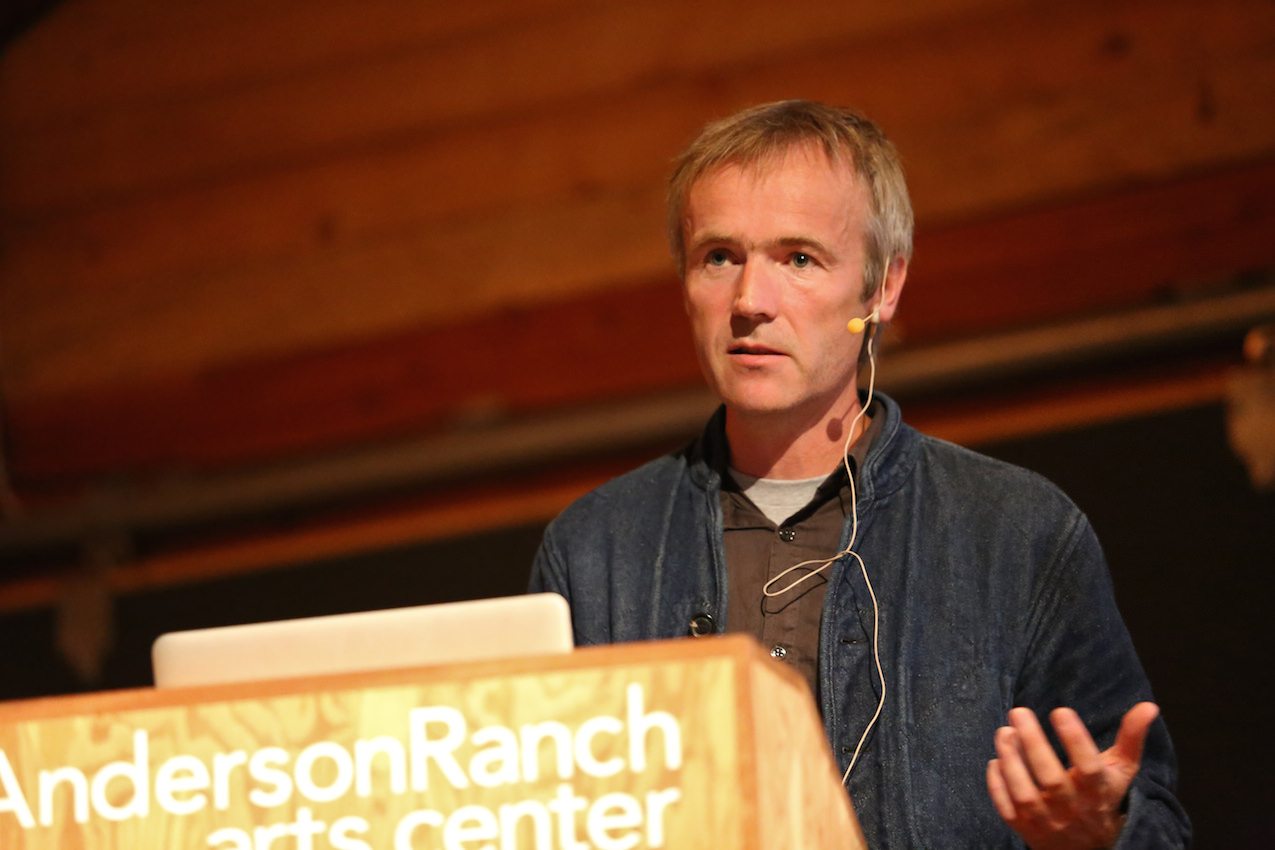Artist and geographer Trevor Paglen’s “The Last Pictures,” is currently on view through March 9 at Metro Pictures. “The Last Pictures” is a compilation of one hundred photographs that have been micro-etched onto a silicon wafer and attached to a disc affixed to the communication satellite Echostar XVI. The exhibition celebrates this launch into Earth’s orbit last November.
Presented by Creative Time, “The Last Pictures,” is a public project engineered with the help of MIT researchers, and created through five years of collaboration between scientists, artists, anthropologists, and philosophers. “The Last Pictures” poses questions about time, space, and humanity’s relation to the past and future as understood through art and science.
The Metro Pictures show makes many of the images and the essence of the project accessible to an audience on Earth, including a selection of prints from the final compilation, a slide show of all the selected photographs, along with many prints of work that didn’t make the final cut. Supplemental research, materials, and models also fill the gallery, altogether sparking larger existential questions.
We sat down with Paglen to discuss evolution and the perceptions of space and time on Earth, phantom drones, aliens, Carl Sagan, Greenwich Mean Time, and Guantanamo Bay.
WHITEWALL: Looking at “The Last Pictures” and considering the context of their existence in space, the question of audience is hard to ignore. Are “The Last Pictures” for an audience of the future or one of the present? Are they for aliens or for humans?
TREVOR PAGLEN: Who knows whether there will be an audience for the project in the distant future. I don’t personally think that there will be one. Given that, there is a guaranteed audience in the present and so, in a way, a big part of the project is creating a very strange frame, a temporal frame, and I’m asking viewers or audiences to imagine that they are aliens or beings a billion years from now, looking back at the humans and trying to see ourselves through alien eyes. And that is the oldest trick in the book in terms of art – take something familiar and make it strange.
But having said that, in terms of the materiality of the object, we really did do a lot of work and a lot research to figure out how it would be archived and how it would last into the deep future. In that sense, this hypothetical future audience is something that I, and the people who worked on the project, thought a lot about. One doesn’t know how to address something in the deep future, so we find a lot of paradoxes at the heart of the project.
WW: We, the audience of today, are just as alien to many of the images as any alien of the future would be?
TP: That’s exactly right. The figure of something in the deep future maps onto the figure of the alien as the unknown thing. In fact, one of the essays of the book is called “Ancient Aliens” (a title of an essay in “The Last Pictures” catalog) and the argument is that the refuse we’ve made is going to be the alien objects of the future. If humans tomorrow found a satellite orbiting around the Earth that we couldn’t explain and we learned that it was a relic from a distant civilization of Earth’s history that we didn’t even know anything about, it would still seem like an alien object even though it came from Earth’s past.
WW: How do you think machines like satellites and cameras have shaped human conceptions of the past and future?
TP: Our relationship to time over the past 200 years has been completely upended. With the advent of communication technologies, and the trains of the 19th-century in particular, time had to be coordinated; the coordination of a universal language of time: Greenwich Mean Time. That was an invention of time, the idea that a second is a second and that noon is noon, that’s an invention, a reinvention of time.
At the same time, you also have the creation of new geographies in time. In other words, sitting here in New York, in real life, I’m about six hours away from California and yet much, much further away from somewhere in upstate New York because I can get on a plane and fly to California, that sort of thing. So you have space becoming elastic around the same time.
WW: And time becoming elastic is a function of space’s elasticity?
TP: Exactly. In geography we called this Space Time Compression. [Karl] Marx famously called this the annihilation of space with time. Predator drones are a great example. You have a pilot in Nevada conducting a war in Pakistan. Where is that war taking place? Those places, Nevada and Pakistan, are collapsed into each other and made into the same geography even though they’re on opposite sides of the world.
WW: How does it feel to have made a mark with such a long life expectancy?
TP: Very disorienting. I’m very self aware that this is a ridiculous project and it is a nonsensical project but, at the same time, I have felt an enormous burden, trying to think through how to approach it in the most ethical way I could.
WW: This ethical dilemma of using only 100 photos to present a history of sorts…
TP: That’s something we cut out right at the beginning, the project is not meant to give any kind of complete notion of history. It’s not meant to be a representation of life or humans.
WW: So, in that sense, it is different from Carl Sagan’s Golden Record, which, correct me if I’m wrong, was a very sincere attempt to encapsulate the best things about life on Earth?
TP: They were sincerely trying to put together a record that would summarize humanity and life on earth for aliens. And they were trying to be generous actually. They were like, “Here’s what we think is beautiful in music, here is…the best we have to offer.” That was their criteria. There were no images of war or poverty or violence. That collection of images presents Earth as a multicultural utopia.
WW: Maybe this is a cynically contemporary point of view but it seems foolhardy to assume that you could present something so definitively. Is it possible to share anything besides a unique point of view?
TP: It’s absolutely impossible.
WW: How would you characterize the point of view of “The Last Pictures?”
TP: The Last Pictures is a collection of images done by a small group of people who thought a lot about the moment of uncertainty that we all felt we were living in. So its an impressionistic collection of images that is thinking about uncertainty, thinking about the ways in which humans have radically changed the Earth’s surface and radically transformed ourselves in the process, and also about the anxiety that we have about the future as a consequence of that. It’s a very limited view; it’s a very situated, very partial, very fragmented, very impressionistic view. That is all it could be. Rather than being an archive of history or a compendium of life it is a kind of poem or a kind of silent film.
WW: Films, poems, and photographs are made to be seen, but “The Last Pictures,” attached to this satellite, is very difficult to see. Yet it has been put in a position, orbiting the Earth, to regard us. It’s an interesting role reversal.
TP: That’s exactly right. That’s the other part of it. Having said that, I don’t think these images will ever be found, they will definitely watch us and watch the oceans rise and the plate tectonics shift and they will just keep watching. They will haunt the earth. They will be a reminder of materiality. They’re not supposed to be found. They’re not an archive. They’re a weird thing. It’s a deeply self-contradictory project and a deeply paradoxical project. What does it mean to make something that won’t be found? These questions are what the project is. I don’t know the answers. But I think these are interesting questions to think about.
Trevor Paglen (b. 1974) is an American artist, geographer, and author. His visual work such as his “Limit Telephotography” and “The Other Night Sky” series has received widespread attention for their technical innovations.
Paglen is the author of three books including Torture Taxi, (co-authored with investigative journalist A.C. Thompson) which was the first book to comprehensively describe the CIA’s extraordinary rendition program, and I Could Tell You But Then You Would Have to be Destroyed by Me, which is a look at the world of black projects through unit patches and memorabilia created for top-secret programs. Hi book, Blank Spots on the Map: The Dark Geography of the Pentagon’s Secret World is a broader look at secrecy in the United States.
He holds a Master of Fine Arts degree from the School of the Art Institute of Chicago and a PhD in geography from the University of California at Berkeley, where he currently works as a researcher.










